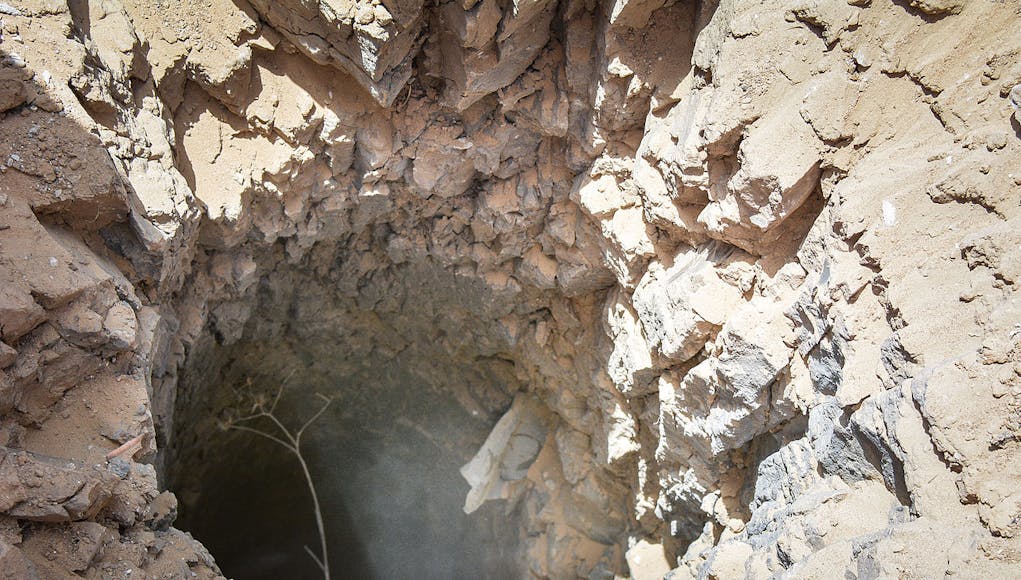What the Israel Defence Forces can expect when they enter the ‘Gaza Metro’ tunnel system.
Amid fears of yet another long war in the region, Israel has now begun its ground campaign in Gaza.
The Israel Defence Forces (IDF) has already claimed several successes in its three-week campaign, including the elimination of several terrorist leaders including Ibrahim Biari, who it described as a “ringleader” of the October 7 attacks, and liberating at least one hostage held by Hamas.
Article by Christopher Morris, University of Portsmouth. This article is the opinion of the author and not necessarily that of the UK Defence Journal. If you would like to submit your own article on this topic or any other, please see our submission guidelines.
But Israel’s military commanders will know that this is unlikely to be a simple operation. Among the factors complicating their mission of eliminating Hamas is the “Gaza Metro”, a vast network of interconnected tunnels within the region. Having invested heavily in subterranean infrastructure over the years, Hamas is counting on this network to aid its survival in the coming weeks.
Underground engineering has a long history in warfare. From antiquity to Vietnam, a range of groups have used tunnels to gain an advantage.
Not only can they provide concealment and freedom of movement, but they also present a range of challenges for the attacking force – they can be hardened against any attacks from the surface. Storming underground networks can also be prohibitively difficult for an attacker, given the limited space available.
Sometimes they work. Sometimes they don’t. For instance, the threat posed by western airpower caused Islamic State (IS) to construct a large network of tunnels. These tunnels made surveillance and airstrikes difficult and were riddled with traps, making capture by ground forces dangerous and difficult.
These benefits only really work if the tunnels are defended, of course, which wasn’t always the case. For instance, in the 2015 battle for Sinjar, the majority of IS fighters were long gone by the time Kurdish land forces arrived to liberate the city.
Hamas terrorist give RT a tour of their tunnel network in Gaza – called the Metro. Video shows Hamas fighters with weapons (ATGMs, RPGs, Snipers, machine guns) waiting in advanced tunnels to conduct surprise counterattacks on @IDF Have power, fuel, other services. pic.twitter.com/CrAKlPNUqM
— John Spencer (@SpencerGuard) October 31, 2023
Established network
Hamas’s tunnel network presents a unique problem for the IDF. There have been tunnel networks in Gaza for years. Initially used for smuggling, they were quickly turned towards offensive uses, playing a role in kidnapping and weapons storage.
The Hamas subterranean networks really began to evolve after 2012, when restrictions were lifted on the importing of building materials to the region. The militant group was able to redirect construction supplies away from civilian infrastructure projects to expand its underground presence.
While the tunnels vary in quality, many are well equipped and hardened, and deep enough to evade detection by ground penetrating radar.
Unsurprisingly, key Hamas allies, including Iran are boasting about the Gaza Metro. The network provides the group with a haven and a means to move around the region unobserved.
It places leadership and organisational infrastructure out of reach from air attacks. The system is laden with supplies as well as weapons and fuel.
Defended, booby-trapped and likely to be populated with human shields and hostages as well as fighters, they will be challenging for even a well-equipped and capable attacking force.
Yet, if not addressed, Hamas may continue to operate irrespective of what happens on the surface. Indeed, as many of the tunnels lead across the border, there is a risk of further incursions, rocket strikes and attacks on IDF forces. And, given the heavily urbanised nature of Gaza, much of the network is beneath civilian infrastructure, which further complicates Israeli operations.
Hamas is a proficient and prolific user of tunnels. But in honing its expertise, the group has also provided Israeli forces with a decades-long crash course in how to deal with their underground operations.
In addition to their own experience with Hamas tunnels, the IDF can also draw upon lessons from the war on terror, where coalition forces had to contend with both natural and purpose-built tunnels, and even US experiences with drug cartels burrowing on their southern border with Mexico.
Bitter experience
While Hamas is counting on its tunnels to cause problems, Israel already has a range of solutions. It has already gained valuable experience in underground operations, having learned hard lessons from the past. A range of innovative purpose-built technologies and strategies can be used to provide the IDF with a technological edge.
Some are simple, such as flooding tunnels with sewage, whereas others are more complex, involving specialised engineering. Some solutions, such as ground-penetrating explosives, might be difficult to use, given the presence of civilians.
Israel has known about the tunnels for a long time and is taking them seriously. Recent operations suggest that the time spent training for this exact scenario is going to pay off, at least to a certain extent.
But dealing with a network of more than 300 miles is still going to represent a massive challenge, and storming or blocking off every part of the system is probably impossible.
Bitter experience has taught Israel most of Hamas’s tactics already – but this does not mean that the group doesn’t have more tricks up its sleeve. Hamas’s recent offensive success was rooted in the way it used a number of relatively low-level capabilities in concert.
For instance, paragliders, ground assaults and rockets only have a limited impact when used individually, but together, were used to devastating effect on October 7.
Now Hamas will be hoping for the same degree of success when acting on the defensive. Depending on how Israel chooses to deal with the issue, they may find their ground forces bogged down in slow-moving subterranean activity, or risk heavy civilian casualties if they simply choose to bomb or collapse the tunnels.
Almost any solution Israel chooses can be turned into a Hamas advantage: both in military and political terms.
Ultimately Israel has no perfect solution to the complex problem posed by the Hamas underground network. But years of dealing with the Hamas Metro means the IDF is not entirely unequipped to confront the challenge.
It seems inevitable that the next days and weeks will be a bitter and bloody struggle, both in the streets of Gaza and as deep as 70 metres below ground.![]()
Christopher Morris, Teaching Fellow, School of Strategy, Marketing and Innovation, University of Portsmouth. This article is republished from The Conversation under a Creative Commons license. Read the original article.













The latest communique from the IDF high command is that entering the tunnels will be a last resort and that is why the very effective SPONGE BOMB was developed which effectively seals the tunnels with rapidly expanding and then solidifying foam.
Perhaps the Hamas terrorists do not need oxygen.
Either way there is no quick fix.
Maybe Israel can get some plumbers in, to ‘pipe’ in water from the med, and flood the tunnels.
That’s exactly what Egypt did in 2015 I quote from Al Jazeera 18/09/15:
Egypt floods Gaza tunnels used for smuggling
The Egyptian army has begun to pump water from the Mediterranean Sea into underground smuggling tunnels connecting Sinai with the besieged Gaza Strip, security officials and witnesses say.
With the stipulation that subterranean hostage rescue op doctrine and tactics are way outside my wheelhouse, presume IDF has some unit(s) which have akillsets similar to SEALs, SAS/SBS. Believe it would be dangerous and unproductive to use IDF reservists for the task. Wonder whether IDF has not already (unofficially) written off recovery of majority (or all) of the hostages? If so, flooding tunnels followed by the permanent sealing of entire system could be deemed appropriate. 🤔😳
Flooding with sewage would cause bio hazard and toxic gas buildup !
Reality is that trying too hard to rescue hostages will end up costing more IDF lives than are saved. Making the tunnels unliveable (without resorting to recognised chemical warfare) is one valid option. Sealing them off is another, but you need to find all the exits. Sewage has a residual effect, unlike sea water.
Sadly, while the IDF may well succeed in neutering this latest crop of terrorists, the ideology and sense of grievance that fuels it will still be there. If not made worse. Killing up to 10,000 (to date-ish) Palestinians is hardly going to resolve the core problems in the area. Ghettoisation of Gaza and the ethnic cleansing of the region are not helping. What is the likelihood that Putin has been encouraging Iran and Syria in this? There needs to be a longer term solution.
A long term solution is not a new idea. It dates back longer than nearly everyone affected can remember. There must be room and cooperation alllowing all parties to live and prosper in the area. Until all sides want that these conflicts will continue. They are not helped by external forces feeding weapons into the conflict zone.
Yes and they have to accept and respect each other. This conflict goes back to pre-biblical times! A continual round of eye for an eye, tooth for a tooth never solves problems.
Agreed. As in NI when both sides are serious about peace there will be no shortage of people & countries wanting to help turn it into a reality.
Unfortunately even before the events of oct/nov there was actually very little appetite for peace even in the general population. In Gaza only 39% supported a peaceful two state solution..with around 57% supporting armed attacks on Israeli civilians…60% of Palestinians believe the goal of a free Palestine should from the river Jordan to the sea ( all of it)…..this has not actually changes much since the early 20c..a
from the Israel side it was around 70% believing in a two state solution but that has slowly eroded to around 50%..those Tabatha don’t believe in a two state solution often point out that of the original Palestinian manage Jordan takes up 78% of it and is Arab…..Isreal taking up around 14% and the occupied territories about 8%….that I think is a less than helpful view.
39% & 50% are not bad statistics probably showing that large proportions of both populations can see the need to sweep away some of the old thinking and face the reality on the ground. It should be noted that those considering the issues in NI, in say the 1980s, on all sides would likely have considered the situation hopeless. It is I suppose possible that this current situation will focus minds which might lead to some form of solution. Stranger things have happened.
Jeremy Corbyn calenders and Corbyn signed photos!!!!
Brilliant Mate – made my day! 😅
They could have done so much better with the tunnels. Bland and in desperate need of plastering and a lick of paint. Disappointing tbh
Take the HS2 tunnel boring machines, put a rectangle of tunnels around Gaza, fit with listening pods, flood.
Even in WW1, the tunnelers were listening for each other. Preventing supplies entering Gaza has to be a long term solution, preventing terrorism leaving Gaza to attack Israel has to be another ‘easy’ win.